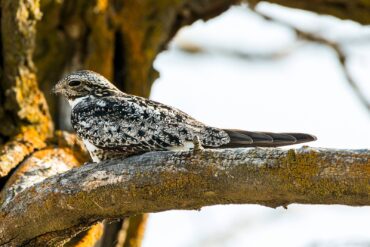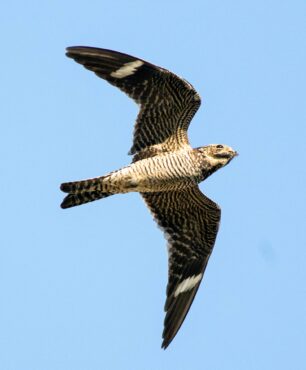
Numerous species of migratory birds breed in West Sound. Many travel thousands of miles from wintering grounds in Mexico and Central America. The later a bird arrives, the farther it has traveled. These species, called long-distance migrants, sometimes spend the nonbreeding season in the Southern Hemisphere.
It may seem strange that some birds spend several months of the year on the road in order to reproduce. For many species, such a trip is necessary to find enough available food and proper nesting areas.
The latest migrant breeder to reach West Sound is often heard before being seen. Although it’s found during the summer months in most areas of North America, it is considered a common species in steep decline. This master of the skies is the common nighthawk.
Having one of the longest migrations of any breeding bird in North America, the common nighthawk spends the winter months in South America, going as far as northern Argentina.
Arriving in West Sound in early June, common nighthawks have the shortest breeding season of any local bird, staying in town for no more than three months. They form flocks of traveling companions by mid-August and by month’s end embark on their epic journey back to the Southern Hemisphere.

The common nighthawk is Western Washington’s only member of the nightjar family, a genus comprised of 89 species worldwide, nine of which reside in North America. A few of its close relatives include the common poorwill of Eastern Washington and the western states, eastern whip-poor-will of the eastern states, and lesser nighthawk of the desert Southwest.
Sometimes called “goatsuckers,” nighthawks and other nightjars were once erroneously thought to drink goat’s milk at night. Some field guides still refer to them by this name.
An uncommon Western Washington species, the common nighthawk can be seen throughout West Sound but is most often observed in the central and southern portions of the region. The most reliable places to find them are the open forests near Seabeck that surround Green Mountain and Wildcat Lake.
Despite the misleading name, nighthawks are neither strictly nocturnal nor birds of prey. They are most active at dawn and dusk as they feast on flying insects. Nighthawks are most often seen while in flight. It’s best to look for them on warm summer evenings, preferably in clear-cuts and other open areas. Listen for their trademark contact calls and look for them flying above the treetops.
The common nighthawk is known for its loud, buzzy, “peent” call that pierces the twilight. Its white-barred, long, pointed wings slice through the air in an erratic, bat-like flight as it forages on the wing.
Males perform spectacular mating and territorial displays by diving to the ground and pulling up at the last second. As they change direction, the air rushes across the wingtips and makes a booming sound like a race car speeding by.
The common nighthawk is larger than a robin and smaller than a crow, with a 2-foot wingspan. It has large eyes and a tiny beak surrounded by short, stiff hairs, called rictal bristles, that are thought to assist in funneling insects into its large mouth.
The cryptic common nighthawk is a master of camouflage with its mottled brown and gray tones that allow it to disappear when motionless. It can be spotted by a keen eye while roosting in the daytime on a tree branch — where, from a distance, it looks like a knot of wood.
The common nighthawk uses its feathered invisibility cloak to protect its eggs and does not build a nest. Instead, the two eggs are laid directly on the ground, usually in a gravelly area. The speckled eggs resemble rocks and are generally safe from predators.
The female incubates the eggs on the bare ground for 18-20 days. Both parents care for the hatchlings, which begin to fly when they are 18 days old. Within a month, the juveniles are on their own. They will then have less than two months to prepare for their first migration, which may take them 6,000 miles from where they hatched.
The common nighthawk has decreased rapidly in recent decades. According to the North American Breeding Bird Survey, it declined by 61 percent from 1966 to 2014. This is partly because nighthawks used to nest on gravel rooftops, which are seldom available now. The excessive use of pesticides is another contributor, as fewer insects means fewer birds.
The common nighthawk spends several months of the year traveling, and details of its life during its impressive migration are largely unknown, adding to its mystique.
Common nighthawks indicate the arrival of summer. Flocks preparing for migration indicate that summer is ending. Needing no passport, these incredible flyers pass over more countries than many people will ever visit. They are worth a second look.



























